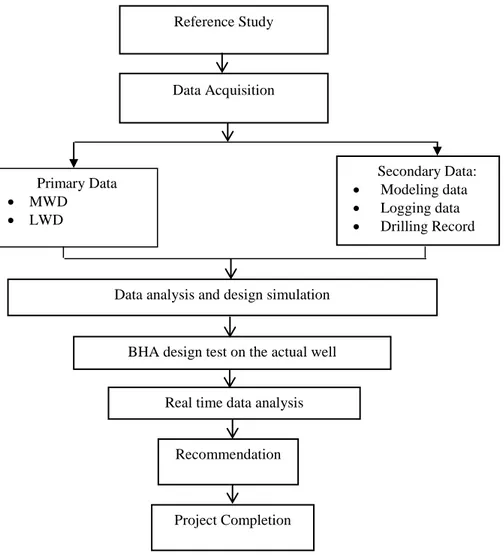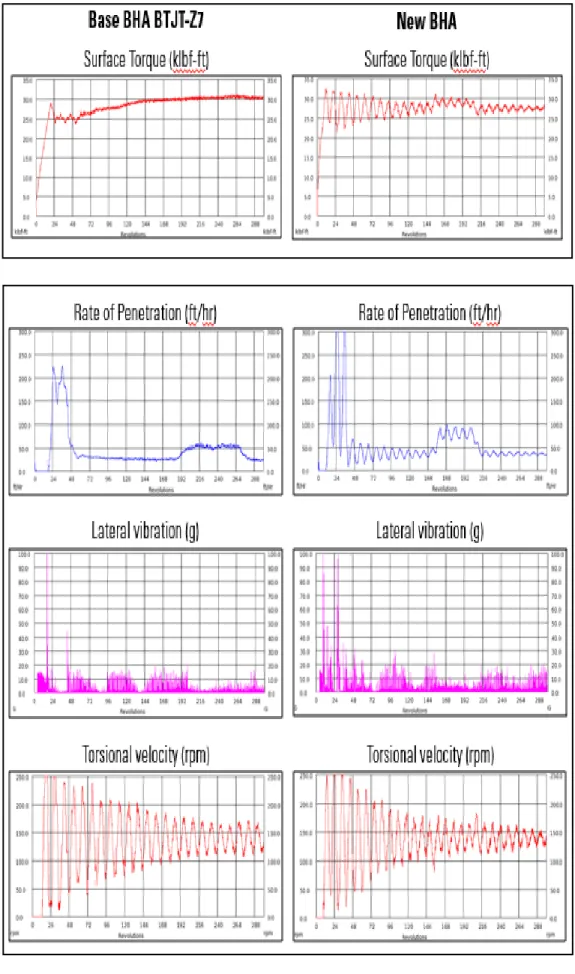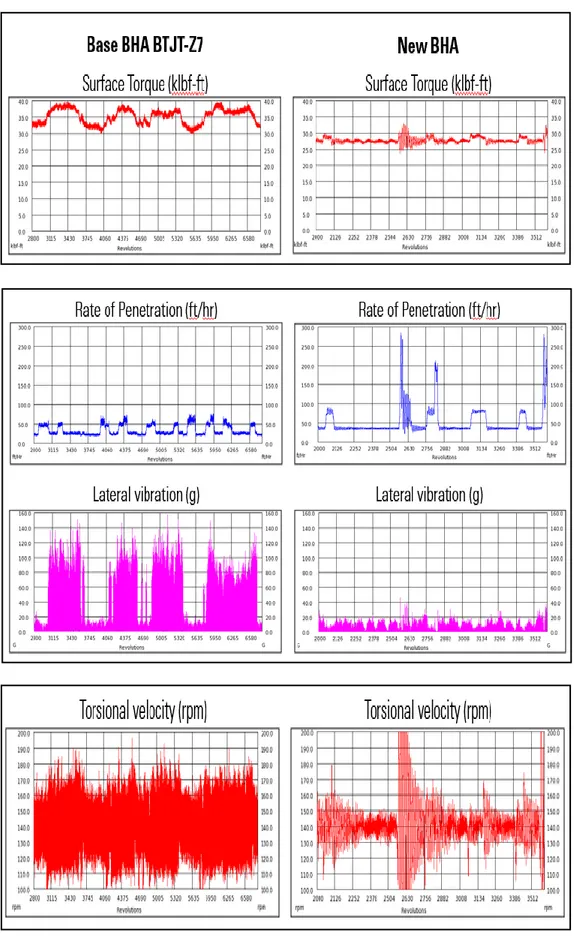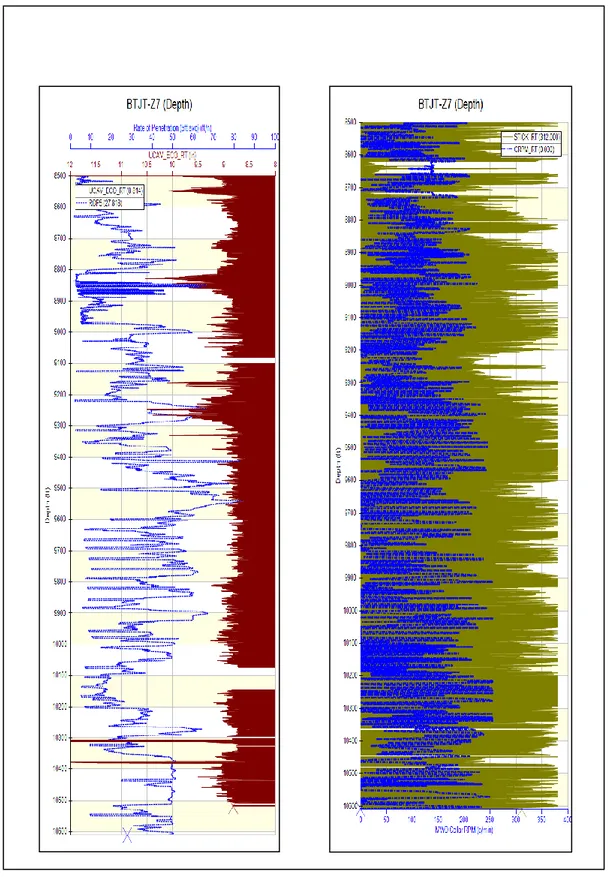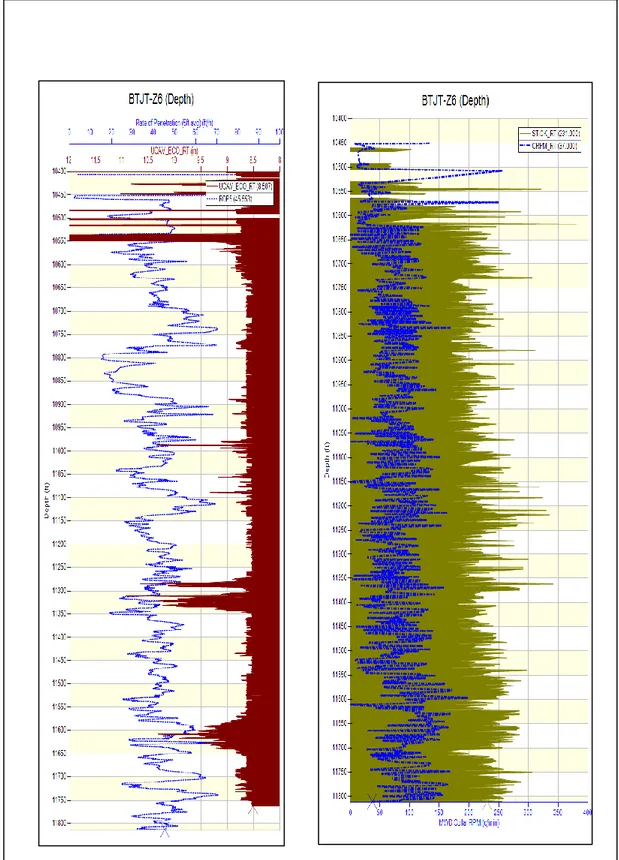53
Optimization of Drillstring Design to Produce More Stable Dynamic
Drilling on Horizontal Drilling by Applying Different Stiffness
Combinations
(Optimasi Desain Drillstring untuk Menghasilkan Dynamic Drilling yang Lebih
Stabil Pada Pengeboran Horizontal dengan Menerapkan Kombinasi Stiffness
yang Berbeda)
Dundie Prasetyo1, Ratnayu Sitaresmi2, Suryo Prakoso2
1PT. Pertamina Hulu Energi 2
Master Program of Petroleum Engineering, Universitas Trisakti, Jakarta
Abstract
Horizontal drilling technique is one of the methodologies that have been widely implemented recently to improve the production of oil and gas wells. Several directional drilling technologies can be utilized to drill the horizontal wells, vary from the simple mud motor technology to Bottom Hole Assembly (BHA) with the advanced motorized rotary steerable system. The most common challenges that are faced on horizontal drilling process are on the torque and the stick-slip throughout drilling process, which can be a technical limiter for the length of horizontal section that would be achieved. Stick-slip is the vibration that occurs due to cyclical rotation acceleration and deceleration of the bit, BHA or drill string. This speed fluctuation can be zero to rate of penetration (ROP) or far in excess of twice the rotational speed measured at the surface. Stick-slip can significantly decrease the ROP, increases tool failures and damage, affects borehole quality, and impacts the data acquisition. Several studies had been done on the stick-slip prevention and mitigation throughout creation of new technology and drilling parameters envelope throughout drilling operation, however no study has ever been done on the modification of the design and arrangement of the BHA itself to produce more stable BHA. Drill pipe is the longest component of the drill string and hence it has biggest contribution towards the drill string dynamic. This study will focus on the analysis of the combination of several designs of the drill-pipe and heavy weight drill-pipe (HWDP) that has different stiffness and characteristic to produce less vibration, more efficient drilling operation and to create zero impact on the data acquisition measured while drilling. FEA drilling dynamic simulator was used to optimize the drill sting configuration. The calculation is made from the depth of 750 m to 2801 m. Based on the drilling simulation results of FEA modeling, it is concluded that the minimum stiffness ratio to give stability of the drill string of Well-Z7 BHA and Well-Z6 BHA is 0.012175272 and 0.07366999, respectively.
Keywords: Horizontal, Stick-Slip, Drill-String, Drill-Pipe, HWDP, Stiffness
Sari
Teknik pengeboran horisontal adalah salah satu metodologi yang telah diterapkan secara luas baru-baru ini untuk meningkatkan produksi sumur-sumur minyak dan gas. Beberapa teknologi pengeboran directional dapat dimanfaatkan untuk mengebor sumur horizontal, bervariasi dari teknologi motor lumpur sederhana hingga Bottom Hole Assembly (BHA) dengan sistem rotary steerable bermotor terkini. Tantangan yang paling umum yang dihadapi pada proses pengeboran horisontal adalah pada torsi dan stick-slip di seluruh proses pengeboran, yang dapat menjadi pembatas teknis untuk panjang bagian horisontal yang mungkin dicapai. Stick-slip adalah getaran yang terjadi karena percepatan dan perlambatan siklus perputaran bit, BHA atau rangkaian pemboran. Fluktuasi kecepatan ini bisa nol untuk laju penembusan (ROP) atau jauh melebihi dua kali kecepatan rotasi yang diukur di permukaan. Stick-slip secara signifikan dapat mengurangi ROP, meningkatkan kegagalan dan kerusakan alat, mempengaruhi kualitas lubang, berdampak pada akuisisi data. Beberapa penelitian telah dilakukan pada pencegahan dan mitigasi stick-slip melalui penciptaan teknologi baru dan parameter pengeboran meliputi seluruh operasi pengeboran, namun tidak ada penelitian yang pernah dilakukan pada modifikasi desain dan susunan BHA itu sendiri untuk menghasilkan lebih stabil BHA. Drill pipe adalah komponen terpanjang dari rangkaian alat pemboran dan karenanya ia memiliki kontribusi terbesar terhadap pergerakan rangkaian pemboran. Studi ini akan fokus pada analisis kombinasi beberapa desain drill pipe dan heavy weight drill-pipe (HWDP) yang memiliki kekakuan dan karakteristik yang berbeda untuk menghasilkan getaran yang lebih kecil, operasi pengeboran yang lebih efisien dan untuk tidak berdampak pada akuisisi data yang diukur saat pengeboran. Simulator digunakan untuk mengoptimalkan struktur rangkaian pemboran. Perhitungannya dibuat dari kedalaman 750 m ke 2801 m. Berdasarkan hasil-hasil simulasi pemborang dari model FEA, disimpulkan bahwa rasio kekakuan minimum untuk memberikan kestabilan rangkaian pemboran BHA Sumur Z7 dan BHA Sumur Z6 berturut-turut adalah 0.012175272 dan 0.07366999.
Kata kunci: Horisontal, Stick-slip, Drill-string, Drill-pipe, HWDP, Kekakuan *Corresponding author
E-mail: [email protected] Tel: +62-8111667583
54 I. INTRODUCTION
Drilling in deep horizontal wells often experience drilling issues related to vibration, erratic torque and stick / slip that can significantly reduce the overall drilling performance. Not simply reducing the drilling performance, the shock and vibrations if not being managed properly will potentially bring damages into downhole tools and drill-string. All those issues will become the limitations to achieve the expected total depth of the horizontal drilling.
The severe speed variation, referred to as stick-slip, is known to be a major source of problems, such as fatigue failures, over-torqued drill pipe connection, bit wear, poor drilling rates, and damages on the electronic component of the downhole tools.
Stick-slip motion is caused by the transition between static and kinetic frictions and are thus a dynamically unstable vibration. Due to the fact that downhole vibration can dramatically decrease the rate of penetration (ROP) in drilling operations. Stick-slip can significantly increase drilling cost. Stick-slip vibration in drill string also increases tool failures, adversely affects borehole quality, and can lead to the coupling of different vibrations. Stick-slip vibration is likely to occur in deep wells due to high rock strength and poor formation drill-ability. Therefore, understanding its causes and predicting its behavior on formation and knowing how to suppress it, are of significant importance in the drilling operation.
The design of BHA on the Madura sea development wells consists of four sections within horizontal reservoir section. The reservoir is normally dominated by carbonate or porous limestone. The analysis towards the torsional
vibration is done through
Measurements-While-Drilling (MWD) tools and the surface drilling parameters. The analysis reveals that the high torque, high stick-slip happens while drilling and rotating in 8.5 in hole.
The objective of the study is to analyze the impact of the stiffness combination on BHA components and how this will reduce the destructive dynamic vibration while drilling horizontal well. This will be related towards the stability of the drill-string and the drilling dynamic that will contribute towards the efficiency of overall drilling operation.
II. METHOD
The procedure of this research is shown in Figure 1. The study will be conducted by analyzing actual torsional vibration and stick-slip in the actual horizonal well drilling through the data generated by MWD tools. The dynamic simulation through finite element analysis then will simulate the most
stable dynamic torsional analysis through several redesigned BHA. The BHA that generates the most stable dynamic torsional analysis will be implemented on the next horizontal drilling well.
The study is done at Petronas Carigali Indonesia drilling team office and implemented in the actual field while drilling one of the horizonal well. The main procedure of this study is divided into two stages: the planning stage and the execution stage.
The planning stage includes the concept creation on the static modeling and dynamic modeling analyses. From both dynamic and static modeling, the pros and cons are analyzed. The drilling execution is done by field team. While drilling, the real time data is observed, monitored and further analyzed to compare the actual to the model.
III. RESULTS AND DISCUSSION
This study is expected to generate the correlation between the pipe stiffness and the stick-slip phenomena and the drilling parameters while drilling the horizontal well. The expected results are:
1. Understand the correlation of the drill pipe stiffness towards the stick-slip phenomena while drilling horizontal well
2. Create the concrete solution on the BHA design where on the last seven horizontal wells that drills kartz formation generates severe stick-slip. In some of the wells were stopped due to the high ratio of the stick-slip.
3. Provide the practical references that is ready to be implemented for the next horizontal well that will drill the same Kartz formation.
One of the challenges in horizontal section drilling is the drilling dynamic of the drill-string, including the lateral vibration, axial vibration, BHA whirling, and also torsional vibration or stick-slip. Stick-slip occurs by the absorption and release of energy because of the difference between static and dynamic friction. Stick- slip in drilling operation can reduce the drilling efficiency, thus reduce the ROP. In long section of horizontal drilling, having high stick-slip will produce accumulation and release of stored energy and increase the risk of twisting the drill-string components. Mitigating high stick-slip phenomenon in carbonates horizontal drilling can increase the non-productive time of drilling.
In the industry, there are several methods of predicting the drill-string mechanic: static analysis, well propagation analysis, modal analysis, and transient dynamic analysis. Static analysis usually used to predict the torque and drag of the
55 drill-string by assuming the drill-string doesn’t move in the wellbore and the string keeps the same deformation all the time.
Well propagation analysis is used to predict the directional capability of a drill-string using a static computational engine based on the calculated BHA deformation and simple bit propagation method. However, this process doesn’t consider the dynamic effect on the BHA. Modal analysis calculate the natural frequency at the drill string with assuming boundary condition, that doesn’t apply in the real world as the boundary keep changing. All of the assumption mentioned above limit the capability of each methodology in predicting the dynamic of the BHA. (SPE/IADC-173008-MS)
Transient dynamic analysis computes the time histories of each location/force and drill-string deformation through certain time/revolution. This time-based simulation run on a Unix platform. This simulation is much more accurate than a static BHA modelling as all of the components modelled in detail individually. The simulation modeled interaction between the cutting structure and formation drilled using rock mechanics derived in the lab. The result of the simulation are the drilling behavior of the whole drill-string components, including the vibration, stress, torque, and even ROP prediction. The rock failure mechanism, in this case the crater generated by the cutting structure to the rock is also being modeled in FEA. Every value gathered from the lab testing then used as a baseline of the mathematical calculation to determine the dynamic effect in the drill-string and vice versa.
Every time the lab received new cutting structure design or new rock to be tested, the cutter-rock interaction test is conducted. The magnitude and the direction of the force experienced by the cutting structure and the rock is recorded and stored in the database.
In 8.5 in hole section of one of the well in BTJT field, the stick-slip occurred and caused the BHA twist-off. FEA drilling dynamic analysis was performed to optimize the drill sting configuration. The sequence of the analysis for this section are: 1. Calibrate the model from the BTJT-Z7, the well
that experienced twisted-off BHA on the 8.5 in hole section based on the field data, such as surface torque, vibration level, and rate of penetration by changing the variable of well friction factor and formation in homogeneity. 2. Using the calibrated model from BTJT-Z7,
optimize the drill string configuration by changing the combination of the drill-pipe. 3. After optimizing BHA is acquired, drilling
parameter road-map is designed.
IV. CONCLUSIONS
After the simulation – opitimization and result, can be concluced that :
1. In horizontal well drilling, drill-pipe stiffness will have big influence on stick-slip severity. Hence mitigation plans must be prepared accordingly.
2. Design, preparation, and risk mitigations of the directional wells need to be done more thoroughly, especially on horizontal wells drilling in Karst formation.
3. Drill-pipe size, stiffness and placement will pose different impact on the stick-slip severity. 4. The conclusion of this study is expected to
provide a concrete solutions towards several issues that spent non-productive time and cost on previous drilling campaign.
REFERENCES
1. Constantijn Raap; Andrew D. Craig; and Ryan
Graham., ―Drillpipe Dynamics
Measurements—Insight Into Drillstring Dysfunctions‖. SPE 145910. Prepared for the 2011 SPE Annual Technical Conference and Exhibition, Denver, 30 October–2 November, 2012.
2. Junichi Sugiura; Robello Samuel; Joachim Oppelt; G.P. Ostermeyer, Braunschweig; John Hedengren; and Paul Pastusek., ―Drilling Modeling and Simulation: Current State and Future Goals‖. SPE 173045. Prepared the 2015 SPE/IADC Drilling Conference and Exhibition, London, 17–19 March, 2015.
3. Johnson, Molly Compton; Fernando Verano; Gail Nelson; Sean Xianping Wu; "Managing
Downhole Vibrations for
Hole-Enlargement-While_Drilling in Deepwater Environment: A Proven Approach Utilizing Drillstring Dynamics Models‖. Prepared for presentation at the SPE Latin American & Caribean Petroleum Engineering Conference held in Lima, Peru, Des. 1-3, 2010. 4. Saeed Al Reda, Hussain Juwaiher, Saudi
Aramco, Nouman Feroze, Venki Karupiah, Sean Xianping Wu and Uyen Partin; ―Advancements in Drillstring Dynamics Modelling Deliver Performance Step-Change, Saudi Arabia‖. SPE 144360. Prepared for presentation at the SPE/IADC Middle East Drilling Technology Conference and Exhibition held in Muscat,Oman, Oct. 24-26, 2011. 5. Christopher W. Guidry; Reena Thomas.,
―Drillstring Dynamics Simulation Optimizes Multilateral Casing Exit Windows‖. SPE 151556. Prepared for presentation at the 2012 SPE Drilling Conference and Exhibition held in San Diego, California, USA, March 6-8, 2012. 6. Tony Collins; ―Analysis of Torsional Shock
56 presentation at the 2012 SPE Drilling Conference and Exhibition held in Amsterdam, Netherlands, March 5-7, 2013.
7. Hatem Oueslati, Jayesh R. Jain, Hanno Reckmann, L.w. Ledgerwood III; ―New Insights Into Drilling Dynamics Though High-Frequency Vibration Measurement and Modelling‖. SPE 166212. Prepared for presentation at the SPE Annual Technical Conference and Exhibition held in New Orleans, Louisiana, USA, Sept.30-Oct. 2, 2013. 8. J.K. Wilson, S.F. Noynaert; ―A New damping
Model for Nonlinear Drillstring Dynamics: Understanding the Effects of Rotation, Eccentricity and Confined Fluid Flow and Their Impact on Unconventional Drillstring Design‖. SPE 178817. Prepared for presentation at the SPE Drilling Conference and Exhibition held in Fort Worth, Texas, USA, March 1-3, 2012. 9. Mohammed Shafik Khaled; ―Effect of
Drillstring Vibration Cyclic Loads on Wellbore Stability‖. SPE 183983. Prepared for presentation at the SPE Middle East Oil & Gas Show and Conference held in Manama, Kingdom of Bahrain, March 6-9, 2017.
10. Andreas Hohl, Carsten hohl, Christian Herbig, Hatem Ouslati; ―Characterization and Mitigation of Mud Motor Vibrations‖. SPE 184711. Prepared for presentation at the SPE Drilling Conference and Exhibitions held in The Hague, The Netherlands, March 14-16, 2017.
11. Schmalhorst, ―Dynamic behavior of a bit-motor-thruster assembly,‖ in Proceedings of the SPE/IADC Drilling Conference, vol. 52823 of SPE, Amsterdam, The Netherlands, March 1999.
12. Barton, F. Baez, and A. Alali, ―Drilling performance improvements in gas shale plays using a novel drilling agitator device,‖ in Proceeding of the North American Unconventional Gas Conference and Exhibition, pp. 886–894, The Woodlands, Tex, USA, June 2011.
13. D. Ochoa, J. Palacio, G. Akinniranye et al., ―A fit for purpose combination of positive displacement motor and rotary steerable systems delivers a step change in drilling optimization in Tomoporo Field: a West Venezuela case study,‖ in Proceedings of the SPE/IADC Drilling Conference and Exhibition, vol. 119428 of SPE, Amsterdam, The Netherlands, March 2009.
14. R. L. Cook, J. W. Nicholson, M. C. Sheppard, and W. Westlake, ―First real time measurements of downhole vibrations, forces, and pressures used to monitor directional drilling operations,‖ in Proceedings of the
SPE/IADC Drilling Conference, SPE no.18651, New Orleans, La, USA, March 1989.
57
Real time data analysis Data analysis and design simulation
Reference Study Data Acquisition Secondary Data: Modeling data Logging data Drilling Record Recommendation
BHA design test on the actual well
Project Completion Primary Data
MWD
LWD
58
59
60
61
